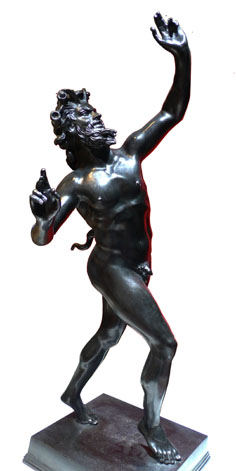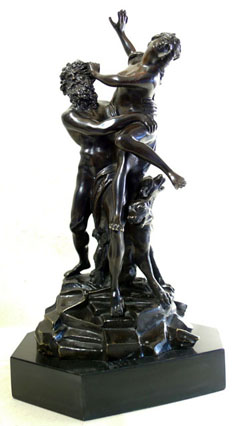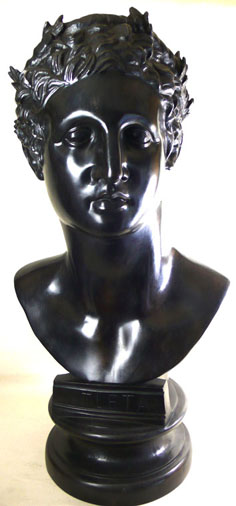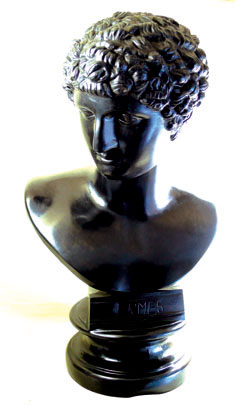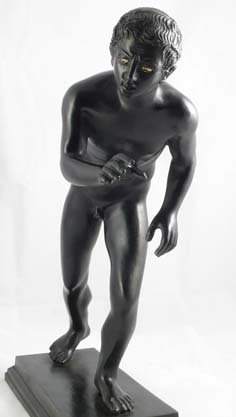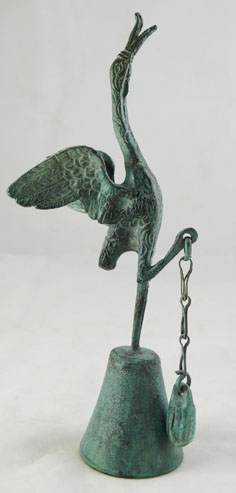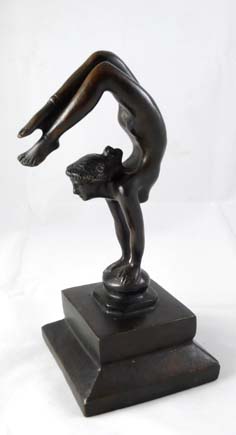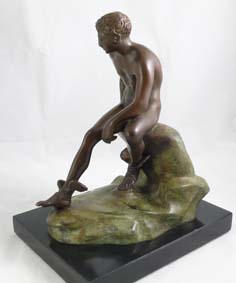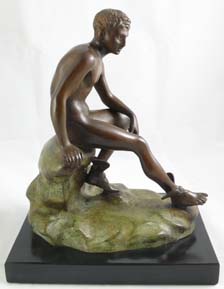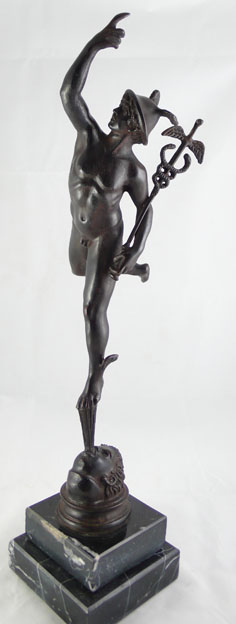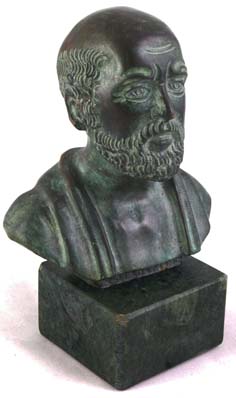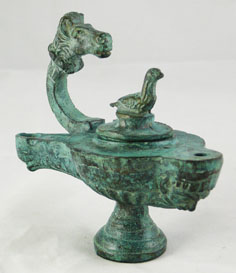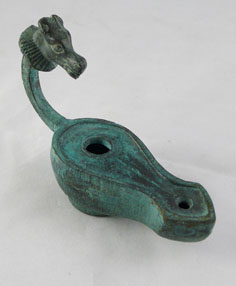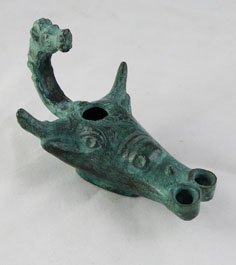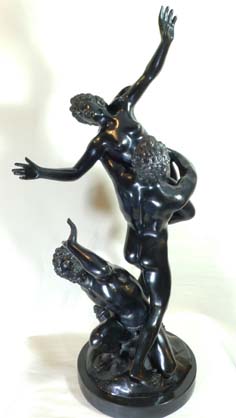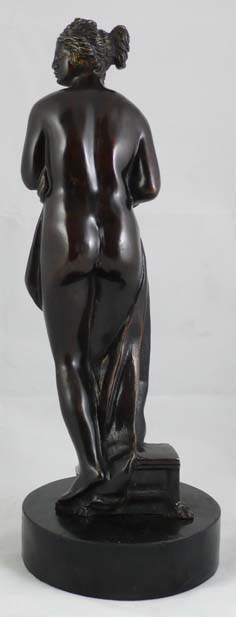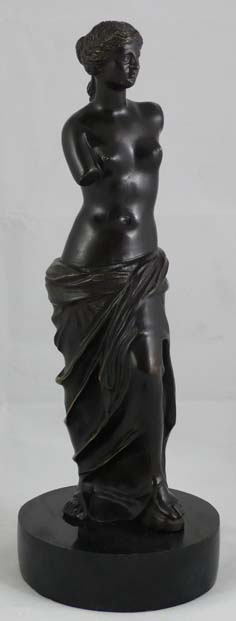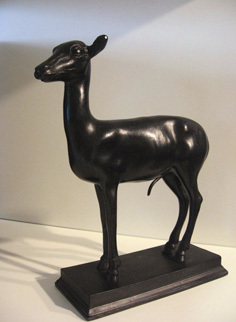Foto
Descrizione Storia
Misure
Prezzo
Fauno Danzante
altezza 71 cm
Ritrovato a Pompei nel 1830.
Originale ellenistico (fine II sec. a.C.)
Museo Archeologico Nazionale, Napoli
Esegue movenze di danza ed era originariamente collocato nell'atrio della casa che prese nome dalla scoperta di questa statuetta (forse presso l'impluvium)
Disponibile nelle patine seguenti:
-Pompei
-Moderna
≈ 71 cm
≈ 40 cm
≈ 30 cm
€1.300,00
€ 540,00
€ 390,00
Gian Lorenzo Bernini 1662, Ratto di Proserpina,
Galleria Borghese, Roma
PROSERPINA
Bernini's principal patron Scipione Borghese funded it but then gave it to Cardinal Ludovisi in 1622, who took it to his villa. It remained there until 1908, when the Italian state purchased it and returned it to the Galleria Borghese.
She was an ancient goddess whose story is the basis of a myth of Springtime. She is the Roman equivalent of the Greek goddess Persephone. She was the daughter of Ceres and Jupiter, and was described as a very enchanting young Proserpina
The Rape of Proserpina is a baroque sculptural group by Bernini executed between 1621 and 1622. It depicts Proserpine being seized and taken to the underworld by Pluto. The twisted contrapposto or figura serpentinata pose is reminiscent of Mannerism, and allows the simultaneous depiction of the abduction, the arrival in the underworld and her prayer to her mother Ceres to return to the real world 6 months a year .
≈40 cm
€ 570,00
LAOCOÖN
In the Vatican Museums, Rome
The son of Acoetes was a Trojan priest of Poseidon, or of Apollo, whose rules he had defied by marrying and having son or had committed an impiety by having sex with his wife in the presence of a cult image in a sanctuary his minor role in the Epic Cycle narrating the Trojan War was of warning the Trojans in vain against accepting the Trojan Horse from the Greeks. "A deadly fraud is this," he said, "devised by the Achaean chiefs!" and for his subsequent divine execution by serpents sent from the sea.
The most detailed description of Laocoön's grisly fate was provided by Quintus Smyrnaeus in Posthomerica, a later, literary version of events following the Iliad. Virgil employed the motif in the Aeneid; the Trojans, according to Virgil, disregarded his advice, however, and were taken in by the deceitful testimony of Sinon; in his resulting anger Laocoön threw his spear at the Horse. Minerva, who was supporting the Greeks, at this moment sent sea-serpents to strangle Laocoön and his two sons, Antiphantes and Thymbraeus.
40 cm x 30 cm
€ 2400,00
HELEN OF TROY
In Greek mythology
The most beautiful woman in Greece, daughter of the god Zeus and of Leda.
She was abducted in childhood by the hero Theseus, who hoped in time to marry her, but she was rescued by her brothers, Castor and Polydeuces (also known as Pollux). Because Helen was courted by so many prominent heroes, her stepfather Tyndareus made all of them swear to abide by Helen's choice of a husband, and to defend that husband's rights should anyone attempt to take Helen away by force.
Helen's beauty was the direct cause of the Trojan War. The ten-year conflict began when the three goddesses Hera, Athena, and Aphrodite asked the Trojan prince Paris to choose the most beautiful among them. After each of the goddesses had attempted to influence his decision, Paris chose Aphrodite, who had promised him the world's most beautiful woman.
≈ 60 cm
€ 1750,00
BUST OF HERACLES
From Ercolano, Villa dei papiri , great peristillio
Augustea copy of originates them scopadeo of the first half of the IV sec. a.C The Herculaneum bronze, also being recognizable like an retort of Herakles type Lansdowne di Skopas, for the addition of the torquata crown and inspired the expression ago thinking next to the images of the Hellenistic dynasty, which loved are made to represent under the aspect of a God or a hero, to begin from Alexander. In this particular case the Herculaneum bust, probable divine retract of a determinable best Hellenistic dynasty, extend the signs of the transfiguration in Heracles.
≈ 60 cm
€ 1750,00
HERMES, MERCURIO
Hermes at Messenger of the gods, the son of the god Zeus and of Maia, the daughter of the Titan Atlas. As the special servant and courier of Zeus, Hermes had winged sandals and a winged hat and bore a golden Caduceus, or magic wand, entwined with snakes and surmounted by wings. He conducted the souls of the dead to the underworld and was believed to possess magical powers over sleep and dreams. Hermes was also the god of commerce, and the protector of traders and herds. As the deity of athletes, he protected gymnasiums and stadiums and was believed to be responsible for both good luck and wealth. Despite his virtuous characteristics, Hermes was also a dangerous foe, a trickster, and a thief. In one version of a characteristic tale, on the day of his birth he stole the cattle of his brother, the sun god Apollo, obscuring their trail by making the herd walk backward. When confronted by Apollo, Hermes denied the theft. The brothers were finally reconciled when Hermes gave Apollo his newly invented lyre. Hermes was represented in early Greek art as a mature, bearded man; in classical art he became an athletic youth, nude and beardless.
Hermes was devoted to his father Zeus, infact when the Ninfa Io was captured from Hera and was hedged by the giant with 100 eyes named Argo, Hermes does the will of the father and sends to sleep the giant with sings and then behead him with a sword.
In Roman mythology Hermes is equivalent to Mercurio.
LUCIUS SENECA
He was a Roman Stoic philosopher, statesman, dramatist, and in one work humorist, of the Silver Age of Latin literature.
Born in Corduba, Hispania about 3 B.C.E., Seneca was the second son of Helvia and Marcus (Lucius) Annaeus Seneca, a wealthy rhetorician known as Seneca the Elder. Both his gens name (Annaeus) and the names of his notable relatives, (e.g., Lucan) indicate his family was originally of Southern Italian, Oscan extraction, most likely hailing from the confluence of modern Apulia, Calabria and Basilicata. Many Southern Italian families, once obtaining Roman citizenship, participated in the colonization of Roman Hispania.
≈ 15 cm
≈ 30 cm
≈ 45 cm
€ 90,00
€ 300
€ 720,00
THE RUNNER OF HERCULANEUM
Nude male figure with the left leg bent forward and the right leg set back, the torso leaning forward, with the right arm bent and the left extended towards the knee.
Placed together with a twin statue (inv. 5626) in the large peristilium of the Villa dei Papiri in Herculaneum, it is probably the copy of a Greek sculpture from the late 4th - early 3rd century BC, celebrating a victorious athlete in one of the major Pan-Hellenic games. There has been considerable speculation about the type of athlete it represents. The right hand is stretched out in front as if to assume a kind of grip, suggesting that the figure might be a wrestler depicted in a watchful position, although the excessively bent-over posture of the torso is anomalous for this type of competition and the limited mobility of the feet appears out of keeping with a sport which requires the greatest possible grip to the ground surface. The slender musculature, the advanced position of the left foot, as if to suggest that the athlete were at the starting line of a race where there would have been a sort of groove to assist the initial dash, seem to support the hypothesis that the statue is the representation of a runner. The placement of the two statues of the runners near the bronze statue of Hermes resting, also conserved in the Museum of Naples, represents an obvious reference to the theme of the Gymnasium, of which Hermes Enagònios (Hermes as umpire of the race, fight or battle) represented the patron god.
≈ 40 cm
€ 450,00
DUCK JINGLE BELL IN BRONZE FROM POMPEII
€ 60,00
ACROBAT IN BRONZE
Movement of an woman acrobat on hand
≈ 30 cm
€ 390,00
HERMES AT REST
( Mercurio )Statue in bronze, roman riproduction like the original of Lisippo.. 330 bC..320 bC. Naples Museo Archeologico Nazionale.Lost-wax casting
Mythology
As a translator, Hermes is a messenger from the gods to humans
Is so the Olympian god of boundaries and of the travelers who cross them, of shepherds and cowherds, of orators and wit, of literature and poets, of athletics, of weights and measures, of invention, of commerce in general, and of the cunning of thieves and liars.
≈ 30 cm
€ 390,00
FLY MERCURY
The artist of this statue is Giambologna
He became well known for a fine sense of action and movement, and a refined, differentiated surface finish. Among his most famous works are the Mercury (of which he did four versions), poised on one foot, supported by a zephyr. The god raises one arm to point heavenwards, in a gesture borrowed from the repertory of classical rhetoric that is characteristic of Giambologna's maniera.
≈ 30 cm
≈ 55 cm
€ 300,00
€ 540,00
Hyppocrates
(ca. 460 BC – ca. 370 BC)
Mythology
He was an ancient Greek physician of the Age of Pericles, and was considered one of the most outstanding figures in the history of medicine.
≈ 15 cm
€ 90,00
DIFFERENTES LAMPS IN BRONZE
Found in differentes archeologicals sites like Pompeii, Herculaneum
€ 72,00
€ 54,00
€ 54,00
THE RATE OF THE SABINES
(rape in this context meaning "kidnapping" (raptio) rather than its prevalent modern meaning of sexual violation)
It's an episode in the legendary early history of Rome narrated by Livy and Plutarch ('Lives' II, 15 and 19).
It provided a subject for Renaissance and post-Renaissance works of art that combined a suitably inspiring example of the hardihood and courage of ancient Romans with the opportunity to depict multiple figures, including semi-clothed women, in intensely passionate struggle. T
≈ 80 cm
€ 1950,00
CALLIPIGE APHRODITE
The statue portrays the goddess who mischievously casts a glance round to admire the perfect line of the rear part of her body: her head is turned behind her right shoulder, accompanied by a slight torsion of the bust, while her raised left arm holds the hems of the chiton.
The name literally means “the one with the beautiful behind”, and refers to the erroneous identification of the type with a statue which we know was made in the second century B.C. and was displayed at Syracuse. In reality, the iconography was already known in the mid-fourth century B.C., while the original of this statue must date to about two centuries later. After its discovery, it was restored by Albacini, who was responsible for the head, the shoulders, the left arm with the hem of the dress, the right hand and the right calf.
≈ 75 cm
€ 1500,00
VENUS OF CANOVA
Venus Italica sculpture from the studio of Antonio Canova (1757-1822)
≈ 30 cm
€ 390,00
APHRODITE OF MILO
The Aphrodite of Milo, better known as the Venus de Milo, is an ancient Greek statue and one of the most famous works of ancient Greek sculpture. Created at some time between 130 and 100 BC, it is believed to depict Aphrodite (Venus to the Romans) the Greek goddess of love and beauty.
It is a marble sculpture, slightly larger than life size at 203 cm (6 ft 8 in) high. Its arms and original plinth have been lost. From an inscription that was on its plinth, it is thought to be the work of Alexandros of Antioch; it was earlier mistakenly attributed to the master sculptor Praxiteles. It is at present on display at the Louvre Museum in Paris.
≈ 30 cm
€ 390,00
GAZELLE IN BRONZE
€ 180,00
THEATRALS MASKS IN BRONZE FROM POMPEII
14 cm
9 cm
7 cm
€ 180,00
€ 75,00
€ 36,00
